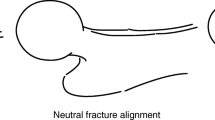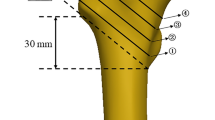Abstract
Complex unstable fracture can complicate the treatment outcome of intertrochanteric fracture of the femur, and fixation failure after surgery is a significant problem in elderly patients. This study aimed to evaluate the effect of fracture geometry on the stability of 3-part intertrochanteric fracture by assessing the fragment size. Four categories (group I: large greater trochanter, small lesser trochanter; group II: large greater trochanter, large lesser trochanter; group III: small greater trochanter, small lesser trochanter; and group IV: small greater trochanter, large lesser trochanter) of a 3-part intertrochanteric fracture model were designed. Three-dimensional computer tomography scanning was performed to measure the volume of each fragment. After fixation with a dynamic hip screw, a cyclic loading study was conducted using a servohydraulic machine. There was a significant difference in fatigue failure between each group. After all specimens had endured 10,000 cycles with a range of loads (100–1,000 N), the mean number of cycles until fixation failure with a load range of 200–2,000 N was 1,467.67 ± 199.92 in group I; 579 ± 93.48, group II; 398.17 ± 37.92, group III; and 268.67 ± 19.92, group IV. Fixation strength was approximately 5 times greater in group I than in group IV. In 3-part intertrochanteric fracture, the sizes of the greater and lesser trochanteric fragments are important factors for determining stability after dynamic compression screw fixation. This study supports our hypothesis that the volumetric ratio of ∆lesser trochanter/∆greater trochanter can be used to predict stability of intertrochanteric femoral fracture.




Similar content being viewed by others
References
Cornwall R, Gilbert MS, Koval KJ, Strauss E, Siu AL (2004) Functional outcomes and mortality vary among different types of hip fractures: a function of patient characteristics. Clin Orthop Relat Res 425:64–71
Michelson JD, Myers A, Jinnah R, Cox Q, Van Natta M (1995) Epidemiology of hip fractures among the elderly. Risk factors for fracture type. Clin Orthop Relat Res 311:129–135
Evans EM (1949) Treatment of trochanteric fractures of the femur. J Bone Joint Surg 31B:190–203
Koval KJ, Zuckerman JD (1994) Hip fractures: II. Evaluation and treatment of intertrochanteric fractures. J Am Acad Orthop Surg 2:150–156
Apel DM, Patwardhan A, PinzurMS DoboziWR (1989) Axial loading studies of unstable intertrochanteric fractures of the femur. Clin Orthop 246:156–164
Boyd HB, Griffin LL (1949) Classification and treatment of inter-trochanteric fractures. Arch Surg 58:853–866
Kyle RF, Gustilo RB, Premer RF (1979) Analysis of six hundred and twenty-two intertrochanteric hip fractures. J Bone Joint Surg 61-A:216–221
Anglen JO, Weinstein JN (2008) American Board of Orthopaedic Surgery Research Committee. Nail or plate fixation of intertrochanteric hip fractures: changing pattern of practice. A review of the American Board of Orthopaedic Surgery database. J Bone Joint Surg Am 90:700–707
Lorich DG, Geller DS, Nielson JH (2004) Osteoporotic pertrochanteric hip fractures: management and current controversies. Inst Course Lecture 53:441–453
Doppelt SH (1980) The sliding compression screw—Today’s best answer for stabilization of intertrochanteric hip fractures. Ortho Clin N Am 11:507–523
Kim WY, Han CH, Park JI, Kim JY (2001) Failure of intertrochanteric fracture fixation with a dynamic hip screw in relation to pre-operative fracture stability and osteoporosis. Int Orthop 25:360–362
Lindskog DM, Baumgaertner MR (2004) Unstable intertrochanteric hip fractures in the elderly. J Am Acad Orthop Surg 12:179–190
Whitelaw GP, Segel D, Sanzone CF, Ober NS, Hadley N (1990) Unstable intertrochanteric/subtrochanteric fractures of the femur. Clin Orthop 252:238–245
Parker M, Handoll H (2006) Intramedullary nails for extracapsular hip fractures in adults. Cochrane Database Syst Rev 3:CD004961
Walsh ME, Wilkinson R, Stother IG (1990) Biomechanical stability of four-part intertrochanteric fractures in cadaveric femurs fixed with a sliding screw plate. Injury 21:89–92
Kaufer H, Matthews LS, Sonstegard D (1974) Stable fixation of intertrochanteric fractures. A biomechanical evaluation. J Bone Joint Surg 56A:899–907
Hartog BDD, Bartal E, Cooke F (1991) Treatment of unstable intertrochanteric fracture. J Bone Joint Surg 73-A:726–733
Haidukewych G (2009) Intertrochanteric fractures: ten tips to improved results. J Bone Joint Surg Am 91:712–719
Su ET, DeWal H, Kummer FJ, Koval KJ (2003) The effect of an attachable lateral support plate on the stability of intertrochanteric fracture fixation with a sliding hip screw. J Trauma 55:504–508
Han SK, Lee BY, Kim YS, Choi NY (2010) Usefulness of multi-detector CT in Boyd-Griffin type 2 intertrochanteric fractures with clinical correlation. Skeletal Radiol 39:543–549
Jensen JS (1980) Classification of trochanteric fractures. Acta Orthop Scand 51:803–810
Talbot M, Zdero R, Schemitsch EH (2008) Cyclic loading of periprosthetic fracture fixation constructs. J Trauma 64:1308–1312
Zdero R, Walker R, Waddell JP (2008) Biomechanical evaluation of periprosthetic femoral fracture fixation. J Bone Joint Surg Am 90:1068–1077
Curtis MJ, Jinnah RH, Wilson V, Cunningham BW (1994) Proximal femoral fractures: a biomechanical study to compare intramedullary and extramedullary fixation. Injury 25(2):99–104
Chan KC, Gill GS (2000) Cemented hemiarthroplasties for elderly patients with intertrochanteric fractures. Clin Orthop 371:206–215
Grimsrud C, Monzon RJ, Richman J, Ries MD (2005) Cemented hip arthroplasty with a novel cerclage cable technique for unstable intertrochanteric hip fractures. J Arthroplasty 20(3):337–343
May JMB, Chacha PB (1968) Displacements of trochanteric fractures and their influence on reduction. J Bone Joint Surg 50:318–323
Gotfried Y (2004) The lateral trochanteric wall. Clin Orthop 425:82–86
Von der Linden P, Gisep A, Boner V, Windolf M, Appelt A, Suhm N (2006) Biomechanical evaluation of a new augmentation method for enhanced screw fixation in osteoporotic proximal femoral fractures. J Orthop Res 24:2230–2237
Thomsen JS, Ebbesen EN, Mosekilde L (2002) Predicting human vertebral bone strength by vertebral static histomorphometry. Bone 30:502–508
Heiner AD (2008) Structural properties of fourth-generation composite femurs and tibias. J Biomech 41(15):3282–3284
Acknowledgments
We thank Katharine O’Moore-Klopf, ELS, for providing editorial assistance.
Conflict of interest
The authors declare that they have no conflicts of interest, financial or otherwise, to report.
Author information
Authors and Affiliations
Corresponding author
Rights and permissions
About this article
Cite this article
Do, JH., Kim, YS., Lee, SJ. et al. Influence of fragment volume on stability of 3-part intertrochanteric fracture of the femur: a biomechanical study. Eur J Orthop Surg Traumatol 23, 371–377 (2013). https://doi.org/10.1007/s00590-012-0983-2
Received:
Accepted:
Published:
Issue Date:
DOI: https://doi.org/10.1007/s00590-012-0983-2




